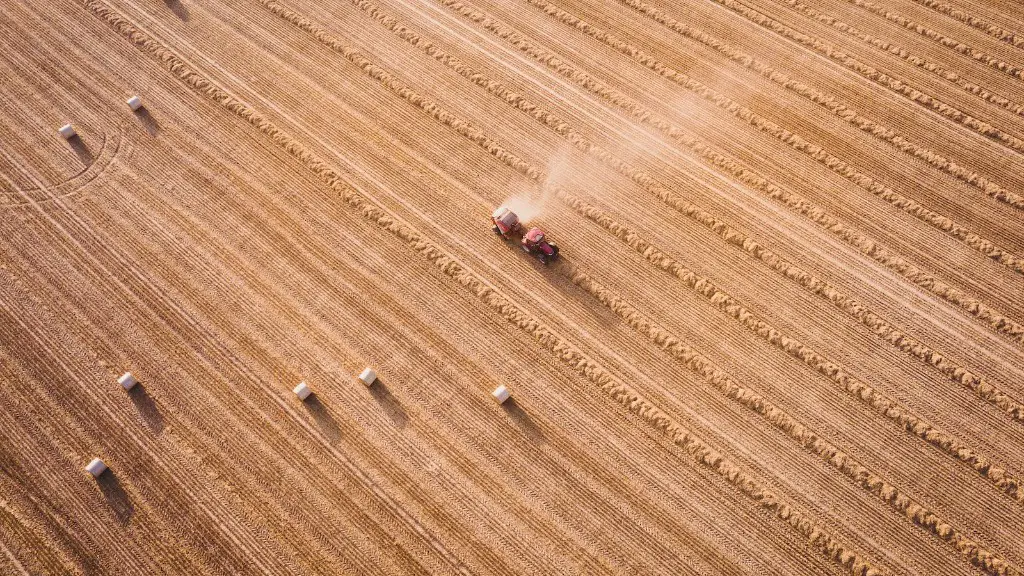The term “genetic modification” (GM) is used to describe the process of transferring a gene from one organism to another, or “genetically engineering” a plant or animal.
A GM crop is one that has been created by transferring genes from one species to another, usually to make the crop more resistant to pests or herbicides, or to improve its yield.
The first GM crops were planted in the United States in 1996, and since then, GM crops have been adopted by farmers in more than two dozen countries around the world.
Genetic modification in agriculture is the process of manipulating the genes of a plant or animal in order to produce a desired trait. This can be done through traditional breeding methods, or through more modern techniques such as genetic engineering.
What is genetic modification explain?
Genetic engineering is a process that uses laboratory-based technologies to alter the DNA makeup of an organism. This may involve changing a single base pair (A-T or C-G), deleting a region of DNA or adding a new segment of DNA.
GMO crops are used in many food products that Americans consume on a daily basis. These ingredients include cornstarch, corn syrup, corn oil, soybean oil, canola oil, and granulated sugar. While a few fresh fruit and vegetables are also available in GMO varieties, the majority of GMO crops are used for processed foods. Americans should be aware of the prevalence of GMO ingredients in their diet and learn more about the potential risks and benefits of consuming these foods.
What are the 3 types of genetic modification
Traditional methods of modifying plants, like selective breeding and crossbreeding, have been around for nearly 10,000 years. These methods involve crossing two plants to create a new plant with desired characteristics. However, these methods can be very time consuming and often result in plants that are only marginally different from the original plants.
Genetic engineering is a much more direct way of modifying plants. With genetic engineering, scientists can directly alter the DNA of a plant to give it desired characteristics. This process is much faster than traditional methods, and it can result in plants that are very different from the original plants.
genome editing is a newer method of modifying plants that is similar to genetic engineering. With genome editing, scientists use special enzymes to cut the DNA of a plant in specific places. They can then insert new DNA into the plant, or delete DNA that they don’t want. This process is very precise, and it can result in plants that are very different from the original plants.
There is a lot of debate surrounding genetically modified (GM) foods. Some people believe that GM foods are safe and can help to improve the quality of food, for example by making crops more resistant to pests and diseases. However, other people are concerned about the potential risks of GM foods, such as the fact that they may contain unknown toxins or allergens. There is currently no conclusive evidence to suggest that GM foods are unsafe, but more research is needed to assess the long-term risks.
What are the benefits of GMOs in agriculture?
Function:
More nutritious food: By modifying the genes of plants and animals, we can create varieties that are more nutritious than their natural counterparts. For example, we can create plants with higher levels of vitamins and minerals, and animals with more lean muscle tissue and less fat.
Tastier food: Genetically modified organisms (GMOs) can be designed to have improved flavor. For example, we can create tomatoes that are sweeter and more flavorful than regular tomatoes.
Disease- and drought-resistant plants: By modifying the genes of plants, we can create varieties that are resistant to diseases and pests. For example, we can create plants that are resistant to herbicides and pests.
Reduced use of pesticides: By modifying the genes of plants and animals, we can create varieties that require less use of pesticides. For example, we can create plants that are resistant to herbicides and pests.
Increased supply of food: By modifying the genes of plants and animals, we can create varieties that grow faster and produce more food. For example, we can create plants that produce more fruits and vegetables, and animals that grow faster and produce more meat.
reduced cost and longer shelf life: By modifying the genes
GMO foods are designed to be healthier and cheaper to produce. Advantages of GMO foods include added nutrients, fewer pesticides, and cheaper prices. Disadvantages of GMO foods can be allergic reactions or increased antibiotic resistance.
What is a type of genetic modification in plants?
Traditional genetic modification methods that have been employed for microbial starter cultures include selection, mutagenesis, conjugation, and protoplast fusion. Selection is a process of choosing organisms with the desired traits for breeding. Mutagenesis is a process of exposing organisms to mutagens to create random mutations, which are then screened for desired traits. Conjugation is a process of transferring genetic material between two organisms. Protoplast fusion is a process of fusion between the protoplasts of two organisms, which creates a hybrid organism with characteristics from both parent organisms.
Genetically modified crops have been developed with desired characters by integrating foreign genes into their genome. Examples of such crops include Bt cotton, Bt Brinjal, Golden Rice, and herbicide-tolerant plants. These crops have been designed to have specific characteristics that make them more beneficial to farmers and consumers. For example, Bt crops are resistant to insect pests, while herbicide-tolerant crops can tolerate herbicide application without being damaged.
What is the importance of genetically modified crops
GMO crops that are tolerant to herbicides can help farmers control weeds without damaging the crops. When farmers use these herbicide-tolerant crops, they do not need to till the soil, which they normally do to get rid of weeds. This can help reduce soil erosion and help the crops grow better.
GMO foods have been a controversial topic for many years, with environmentalists expressing concerns about the impact that they may have on the environment. These concerns typically center around three main points: the risk of outcrossing (where genes from GMO foods pass into wild plants and other crops), the negative impact on insects and other species, and the reduction in other plant types (leading to a loss of biodiversity).
While there is no definitive answer as to whether or not GMO foods are harmful to the environment, it is important to be aware of the potential risks and to monitor the situation closely.
What are the 5 best examples of genetic modification?
10 successful examples of genetic modification:
1. Mouse-ear cress
2. Western corn rootworm
3. European corn borer
4. Bananas
5. Abiotic stress
6. Onions that do not make you cry
7. Golden rice
8. Purple tomatoes
9. Carrots that help prevent osteoporosis
10. More items
More than 15 years after their first successful commercial introduction in the United States, genetically engineered (GE) seeds have been widely adopted by US corn, soybean, and cotton farmers. Still, some questions persist regarding the potential benefits and risks of GE crops.
There is no question that GE crops have brought substantial benefits to farmers in terms of increased yields and reduced pesticide use. However, there are legitimate concerns about the potential for GE crops to interbreed with non-GE crops and create new, potentially harmful, strains of plants.
There is also concern that the over-reliance on GE crops could lead to the development of pests and diseases that are resistant to the GE traits. This could create major problems for farmers and lead to the need for even more toxic pesticides.
Overall, the jury is still out on GE crops. There are clearly benefits, but there are also potential risks that need to be considered.
What is the most common genetic modification of food crops
While soy is a common genetically modified crop in the United States, it is important to be aware of the various forms it can take. Whole soy beans, oil, and soy lecithin are all common forms of soy that can be found in many products. When reading labels, be sure to look for these ingredients, as they may indicate that a product contains genetically modified soy.
GMOs can be found in a variety of food products that we consume on a daily basis. While some people may not be comfortable with the idea of eating genetically modified organisms, it is important to remember that GMOs can be found in a variety of foods that we commonly eat – such as corn, soybeans, and cotton. While there is always the potential for risks associated with any type of genetic modification, it is important to remember that GMOs can also be turned into products that are safe for human consumption, such as cornstarch, corn syrup, soybean oil, canola oil, corn oil, or granulated sugar. Additionally, genetically modified cotton can be used in textiles, and scientists can change organisms to be used in medications like human insulin. Ultimately, it is up to each individual to decide whether or not they are comfortable consuming GMOs, but it is important to be informed about where they can be found and what their potential benefits and risks are.
Do GMOs harm the environment?
The main point to take away from this topic is that genetic modification can have a significant impact on the environment, and this needs to be taken into account when considering whether or not to introduce genetically modified organisms into an area. There are a number of potential effects that need to be considered, such as the impact on existing species, and the possibility of new, more dominant species emerging. The licensing procedure takes all of these factors into account in order to make a decision on whether or not it is safe to proceed.
GMO crops have been shown to reduce the amount of pesticides needed for farming, which can save money and reduce the amount of harmful chemicals that end up on crops. When farmers use herbicide-tolerant crops, they can reduce the need to till the soil to control weeds, which can further reduce the amount of pesticides and other chemicals needed for farming.
What are the disadvantages of GMOs in agriculture
There are a number of practical concerns around the use of GM crops, including the rise of insect pests and weeds that are resistant to pesticides. Other concerns around GM crops include the loss of broad seed variety access for farmers and the rising cost of seeds as well as the increased dependency on multinational seed companies.
1) Potential impact on non-target species: Genetically modified crops may have an impact on non-target species, for example by changing the composition of the local ecosystem.
2) Potential for increased weediness: One of the main advantages of genetically modified crops is that they are often engineered to be herbicide-resistant. However, this can also lead to increased weediness, as herbicide-resistant weeds can spread and become more difficult to control.
3) Increase in toxin levels in the soil: Genetically modified crops may be engineered to produce toxins that kill pests or weeds. However, these toxins can also build up in the soil, potentially harming other organisms.
4) Exchange of genetic material between the transgenic crop and related plant species: There is a risk that the genetic material from genetically modified crops could be exchanged with related plant species, for example through pollen transfer. This could result in the transfer of herbicide-resistance or other traits to those species.
5) Selection for: One of the main disadvantages of genetically modified crops is that they can select for traits that are not desirable, for example herbicide-resistance. This can lead to the development of ‘superweeds’ or ‘superpests
Warp Up
The process of genetic modification in agriculture refers to the direct manipulation of the genetic material of crops in order to improve their traits. This can be done in a number of ways, including the introduction of new genes, the alteration of existing genes, or the deletion of genes. Common goals of genetic modification include the development of crops that are more resistant to pests and disease, as well as those that are able to better tolerate environmental stresses such as drought.
Most crops grown in the United States have been genetically modified in some way to make them more resistant to disease, pests, and herbicides. Proponents of GM crops argue that they are necessary to feed the world’s rapidly growing population. However, critics say that GM crops are not safe and that they threaten the environment.





